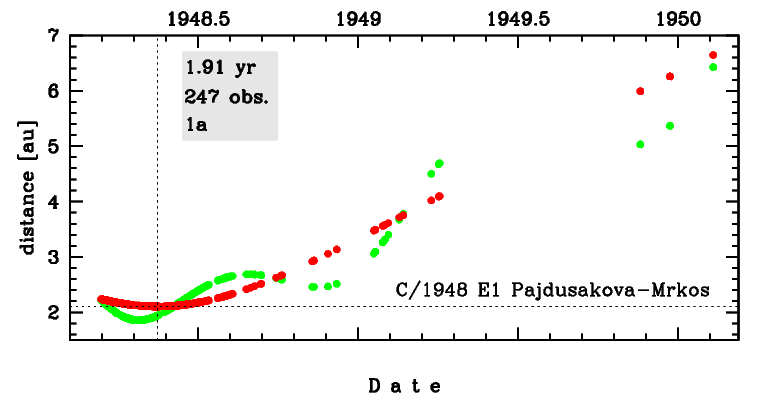C/1948 E1 Pajdusakova-Mrkos
more info
Comet C/1948 E1 was discovered on 13 March 1948 by Ľudmila Pajdušáková and Antonín Mrkos, at Skalnaté Pleso Observatory, Slovakia. Prediscovery images were found by George van Biesbroeck on plates exposed on 15 February and 5 March at Yerkes Observatory (Wisconsin, USA). At the moment of discovery, the comet was two months before perihelion passage, and it was last seen on 9 February 1950. [Kronk, Cometography: Volume 4].
This comet made its closest approach to the Earth on 24 April 1948 (1.860 au), that is about three weeks before perihelion passage.
Solution given here is based on data spanning over 1.912 yr in a range of heliocentric distances from 2.240 au through perihelion (2.107 au) to 6.646 au.
This Oort spike comet suffers almost negligible planetary perturbations during its passage through the planetary system, and it will enter the planet zone as Oort spike comet in the next perihelion passage (see future barycentric orbit).
More details in Królikowska et al. 2014.
This comet made its closest approach to the Earth on 24 April 1948 (1.860 au), that is about three weeks before perihelion passage.
Solution given here is based on data spanning over 1.912 yr in a range of heliocentric distances from 2.240 au through perihelion (2.107 au) to 6.646 au.
This Oort spike comet suffers almost negligible planetary perturbations during its passage through the planetary system, and it will enter the planet zone as Oort spike comet in the next perihelion passage (see future barycentric orbit).
More details in Królikowska et al. 2014.
| solution description | ||
|---|---|---|
| number of observations | 247 | |
| data interval | 1948 03 13 – 1950 02 09 | |
| data type | perihelion within the observation arc (FULL) | |
| data arc selection | entire data set (STD) | |
| range of heliocentric distances | 2.36 au – 2.11 au (perihelion) – 6.65 au | |
| detectability of NG effects in the comet's motion | NG effects not determinable | |
| type of model of motion | GR - gravitational orbit | |
| data weighting | YES | |
| number of residuals | 431 | |
| RMS [arcseconds] | 1.48 | |
| orbit quality class | 1a | |
| next orbit statistics, both Galactic and stellar perturbations were taken into account | ||
|---|---|---|
| no. of returning VCs in the swarm | 5001 | * |
| no. of escaping VCs in the swarm | 0 | |
| no. of hyperbolas among escaping VCs in the swarm | 0 | |
| next reciprocal semi-major axis [10-6 au-1] | 32.08 – 35.47 – 38.90 | |
| next perihelion distance [au] | 30.9 – 31.7 – 32.2 | |
| next aphelion distance [103 au] | 51.4 – 56.3 – 62.3 | |
| time interval to next perihelion [Myr] | 4.1 – 4.6 – 5.4 | |
| percentage of VCs with qnext > 20 | 100 | |
| next_g orbit statistics, here only the Galactic tide has been included | ||
|---|---|---|
| no. of returning VCs in the swarm | 5001 | * |
| no. of escaping VCs in the swarm | 0 | |
| no. of hyperbolas among escaping VCs in the swarm | 0 | |
| next reciprocal semi-major axis [10-6 au-1] | 31.77 – 35.22 – 38.68 | |
| next perihelion distance [au] | 5.6 – 8.8 – 16 | |
| next aphelion distance [103 au] | 51.7 – 56.8 – 62.9 | |
| time interval to next perihelion [Myr] | 4.1 – 4.7 – 5.5 | |
| percentage of VCs with qnext < 10 | 62 | |
| percentage of VCs with 10 < qnext < 20 | 33 | |
| percentage of VCs with qnext > 20 | 5 | |
